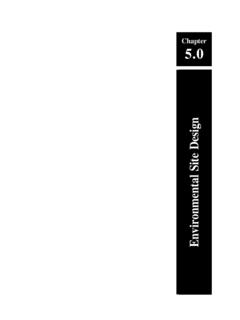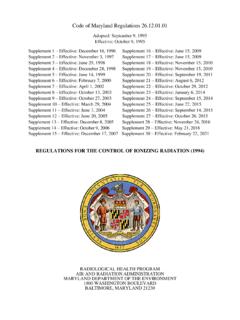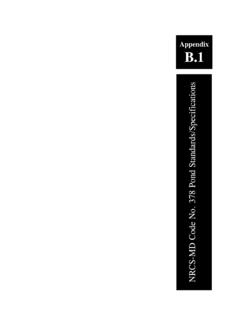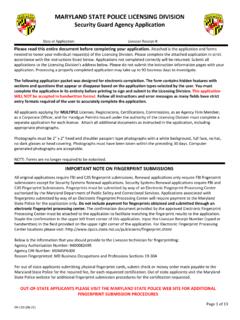Transcription of Advancing Stormwater Resiliency in Maryland (A-StoRM ...
1 Advancing Stormwater Resiliency in Maryland (A-StoRM). Maryland 's Stormwater Management Climate Change Action Plan FY 2021 Data Prepared for: Bill Ferguson, Senate President Maryland General Assembly Adrienne A. Jones, House Speaker Maryland General Assembly Maryland DEPARTMENT OF THE ENVIRONMENT. 1800 Washington Boulevard Baltimore, MD 21230 410-537-3314 800-633-6101 x3314 TTY Users: 7-1-1. Larry Hogan, Governor Boyd K. Rutherford, Lt. Governor Ben Grumbles, Secretary Horacio Tablada, Deputy Secretary Background Urban and riverine flooding is a growing issue in Maryland .
2 The increasing number of extreme rainfall events that produce intense precipitation will continue to lead to more urban and riverine flooding events unless steps are taken to mitigate their impacts. The 2017 National Climate Assessment indicates that heavy downpours are increasing nationally, especially over the last three to five decades. The largest increases are in the Midwest and Northeast. Increases in the frequency and intensity of extreme precipitation events are projected for all regions 1. The University of Maryland 's Center for Disaster Resilience has characterized urban flooding as a significant source of economic loss, social disruption, and housing inequality.
3 2 The torrential downpours that Maryland recently experienced with Hurricane Ida overwhelmed drainage systems that flooded many roads, businesses, and homes, causing property damage and death. The even more severe impacts that were experienced in New York and New Jersey illustrate the growing public safety risk associated with extreme precipitation events. Maryland worked to address these flooding issues in 2020 by updating Maryland 's Stormwater management law, signed by Governor Hogan, that became effective on June 1, 2021.
4 The state's Stormwater Management Law, Environment Article , now requires the Maryland Department of the Environment (MDE) to report on the most recent precipitation data available, investigate flooding events since 2000, and update Maryland 's Stormwater quantity management standards for flood control. A report on MDE's plans to update Stormwater quantity standards is due to the Maryland General Assembly by November 1, 2021, and thereafter, on updates to the Stormwater management regulations and other regulations adopted pursuant to this statute.
5 The statute requires MDE to consult on the impact of any proposed regulations, at least six months prior to adoption, with the following stakeholders: The Commission on Environmental Justice; and Stakeholders with expertise on Stormwater design standards and climate science, including stakeholders from: o An academic institution o The Chesapeake Bay Program o The Chesapeake Bay Commission o The Maryland Department of Emergency Management o The Maryland Association of Soil Conservation Districts o Local Government o A private sector entity with design and construction experience o An association that has expertise in Stormwater restoration projects 1.
6 USGCRP, 2017: Climate Science Special Report: Fourth National Climate Assessment, Volume I [Wuebbles, , Fahey, Hibbard, Dokken, Stewart, and Maycock (eds.)]. Global Change Research Program, Washington, DC, USA, 470 pp, doi: 2. University of Maryland , Center for Disaster Resilience, and Texas A&M University, Galveston Campus, Center for Texas Beaches and Shores. The Growing Threat of Urban Flooding: A National Challenge. 2018. College Clark School of Engineering. 1. Precipitation Data Available MDE is to report on the most recent precipitation data available, defined in the statute as historical data that describes the relationship between precipitation, intensity, duration, and return period (frequency).
7 Known as intensity-duration-frequency (IDF) curves, this data is used in various hydrologic models to predict runoff rates and quantities. This information is the basis for both Stormwater quality and quantity management design standards. The following are the most recent statewide precipitation data available: 2006 National Oceanic and Atmospheric Administration (NOAA) Atlas 14, Precipitation-Frequency Atlas of the United States, Volume 2,3 includes record data through December 2000;. In early 2021, Maryland Department of Transportation (MDOT), along with the states of Delaware, Virginia, and North Carolina agreed to fund an update to the 2006 NOAA.
8 Atlas 14 precipitation data. This work, which began in federal fiscal year 2022, is expected to be completed within three years and will include future rainfall predictions;. In May 2021, a consortium of universities and the RAND Corporation published forecasted precipitation information using two air emissions scenarios (RCP and RCP. ), and two time periods ( , 2020-2070 and 2050-2100).The forecasted precipitation data can be found at The 2006 Atlas 14 precipitation data and the RAND Corporation climate projections incorporate regional atmospheric and topographic variability.
9 Both are available for a number of locations across the state. Table 1 provides, for one location in Maryland , an example of the comparison of precipitation information between the 2006 Atlas 14, and the RAND Corporation's projections due to climate change. Table 1: Atlas 14 and RAND forecasted precipitation information at United States Naval Academy (24 hour event). United States Naval Academy Rainfall Station Projected precipitation using RCP Planning Horizon Planning Horizon Probability of 2020 to 2070 2050 to 2100.
10 Occurrence in Atlas 14. Any Given Precipitation Projected % change Projected % change Year (inches) (inches) from Atlas 14 (inches) from Atlas 14. 50% 10% 1% 3. NOAA Atlas 14, Precipitation-Frequency Atlas of the United States, Volume 2. Version Geoffrey M. Bonin , 2006. 2. MDE's Plans for Updating Stormwater Quantity Control Standards for Watersheds Defining a flooding event The first step in developing a plan to update Stormwater quantity control standards for watersheds, where flooding events have occurred, is to define flooding event: The Federal Emergency Management Agency (FEMA) defines flooding as.










